Themed collection Challenges in analysis of complex natural mixtures

Poster titles
List of participants
Systems chemical analytics: introduction to the challenges of chemical complexity analysis
We present concepts of complexity, and complex chemistry in systems subjected to biotic and abiotic transformations, and introduce analytical possibilities to disentangle chemical complexity into its elementary parts as a global integrated approach termed systems chemical analytics.

Faraday Discuss., 2019,218, 9-28
https://doi.org/10.1039/C9FD00078J
The blind men and the elephant: challenges in the analysis of complex natural mixtures
Structural characterisation of the complete chemical milieu within complex mixtures is challenging. A summary of the discussions at this Faraday meeting is presented with an aim of highlighting where complex natural mixture analysis stands today.

Faraday Discuss., 2019,218, 524-539
https://doi.org/10.1039/C9FD00074G
Combating selective ionization in the high resolution mass spectral characterization of complex mixtures
Here, we describe three separations that can help overcome selective ionization in the analysis of petroleum samples.
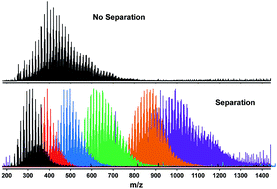
Faraday Discuss., 2019,218, 29-51
https://doi.org/10.1039/C9FD00005D
Challenges in the decomposition of 2D NMR spectra of mixtures of small molecules
In this paper we present a general approach for the blind identification of compounds from solutions using NMR spectroscopy and blind source separation algorithms.
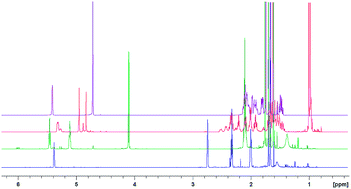
Faraday Discuss., 2019,218, 459-480
https://doi.org/10.1039/C9FD00014C
Multivariate analysis applied to complex biological medicines
Principal component analysis of 13C–1H HSQC NMR spectra allows heparin from different animal sources to be differentiated, as well as spectral features that are specific to each heparin type to be identified.
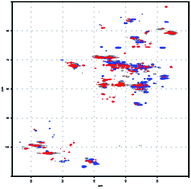
Faraday Discuss., 2019,218, 303-316
https://doi.org/10.1039/C9FD00009G
Systems biology approach to elucidation of contaminant biodegradation in complex samples – integration of high-resolution analytical and molecular tools
We present here a data-driven systems biology framework for the rational design of biotechnological solutions for contaminated environments with the aim of understanding the interactions and mechanisms underpinning the role of microbial communities in the biodegradation of contaminated soils.

Faraday Discuss., 2019,218, 481-504
https://doi.org/10.1039/C9FD00020H
Online supercritical fluid extraction mass spectrometry (SFE-LC-FTMS) for sensitive characterization of soil organic matter
We report a novel technical approach for subcritical fluid extraction (SFE) for organic matter characterization in complex matrices such as soil.

Faraday Discuss., 2019,218, 157-171
https://doi.org/10.1039/C9FD00011A
Unraveling the complexity of complex mixtures by combining high-resolution pharmacological, analytical and spectroscopic techniques: antidiabetic constituents in Chinese medicinal plants
In the present study, fourty medicinal plant samples collected in China were tested for inhibitory activity against α-glucosidase, α-amylase, and protein-tyrosine phosphatase 1B (PTP1B).
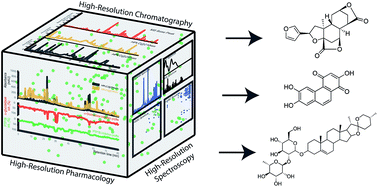
Faraday Discuss., 2019,218, 202-218
https://doi.org/10.1039/C8FD00223A
On the benefits of using multivariate analysis in mass spectrometric studies of combustion-generated aerosols
Building on a recently proposed comprehensive methodology, we propose herein a comparative analysis of soot particles produced by three different sources.
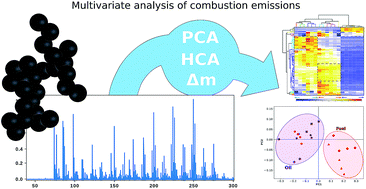
Faraday Discuss., 2019,218, 115-137
https://doi.org/10.1039/C8FD00238J
Joint and unique multiblock analysis of biological data – multiomics malaria study
In this work we used Joint and Unique MultiBlock Analysis (JUMBA) for the integrated analysis of lipidomic, metabolomic and oxylipins data sets obtained from profiling of plasma samples from children infected with P. falciparum malaria.

Faraday Discuss., 2019,218, 268-283
https://doi.org/10.1039/C8FD00243F
An integrated approach for mixture analysis using MS and NMR techniques
We suggest an improved software pipeline for mixture analysis.
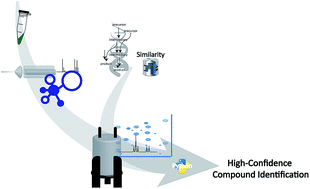
Faraday Discuss., 2019,218, 339-353
https://doi.org/10.1039/C8FD00227D
Resolving complex hierarchies in chemical mixtures: how chemometrics may serve in understanding the immune system
In this paper, we explore the ways in which manual sequential gating, machine learning and chemometrics compare, and show complementary strength in the analyses of the hierarchies of multicolour flow cytometry data, to resolve molecular and cell mixtures into insightful contributions to the immune system.
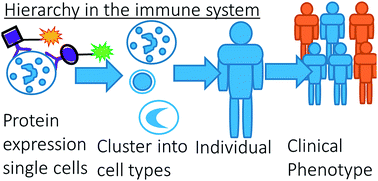
Faraday Discuss., 2019,218, 317-338
https://doi.org/10.1039/C9FD00004F
Understanding the structural complexity of dissolved organic matter: isomeric diversity
In the present work, the advantages of ESI-TIMS-FT-ICR MS to address the isomeric content of dissolved organic matter are studied.
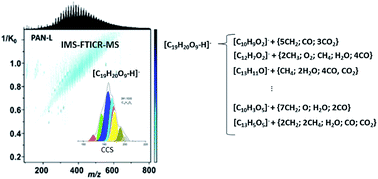
Faraday Discuss., 2019,218, 431-440
https://doi.org/10.1039/C8FD00221E
Deciphering complex metabolite mixtures by unsupervised and supervised substructure discovery and semi-automated annotation from MS/MS spectra
Integration of MS2LDA substructure discovery with MAGMa spectral annotations and ClassyFire term predictions complemented with MotifDB significantly advances metabolite annotation.
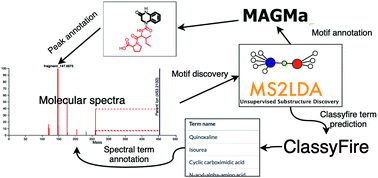
Faraday Discuss., 2019,218, 284-302
https://doi.org/10.1039/C8FD00235E
Perspectives on the future of multi-dimensional platforms
A practical example, the characterization of polysorbates by high-resolution comprehensive two-dimensional liquid chromatography in combination with high-resolution mass spectrometry, is described as a culmination of recent developments in 2D-LC and as an illustration of the current state of the art.
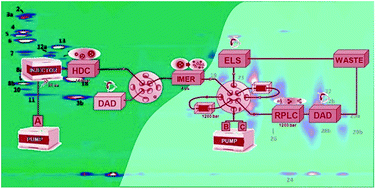
Faraday Discuss., 2019,218, 72-100
https://doi.org/10.1039/C8FD00233A
Structural investigation of coal humic substances by selective isotopic exchange and high-resolution mass spectrometry
We report a selective liquid-phase hydrogen/deuterium exchange coupled to ultra-high resolution FTICR MS for structural investigations of individual constituents of humic substances isolated from coal samples of different origin.

Faraday Discuss., 2019,218, 172-190
https://doi.org/10.1039/C9FD00002J
Complexity of dissolved organic matter in the molecular size dimension: insights from coupled size exclusion chromatography electrospray ionisation mass spectrometry
This paper investigates the relationship between apparent size distribution and molecular complexity of dissolved organic matter from the natural environment.
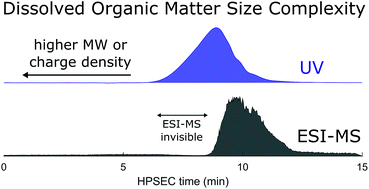
Faraday Discuss., 2019,218, 52-71
https://doi.org/10.1039/C8FD00222C
Automatised pharmacophoric deconvolution of plant extracts – application to Cinchona bark crude extract
We report an on-line NMR dereplication pipeline, from raw data to spectral fingerprints of the active compounds.
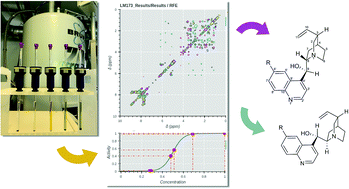
Faraday Discuss., 2019,218, 441-458
https://doi.org/10.1039/C8FD00242H
Reduced dimensionality hyphenated NMR experiments for the structure determination of compounds in mixtures
A suite of NMR experiments using combined chemical shifts to separate resonances in two rather than three dimensions.

Faraday Discuss., 2019,218, 191-201
https://doi.org/10.1039/C9FD00008A
Application of novel solid phase extraction-NMR protocols for metabolic profiling of human urine
Novel SPE-NMR methods were developed for selective retention of metabolites in human urine.
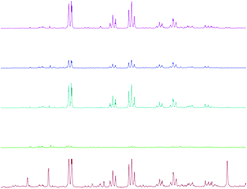
Faraday Discuss., 2019,218, 395-416
https://doi.org/10.1039/C8FD00220G
Collection and identification of an unknown component from Eugenia uniflora essential oil exploiting a multidimensional preparative three-GC system employing apolar, mid-polar and ionic liquid stationary phases
MDGC-Prep is used in combination with NMR, GC-FTIR and GC-MS analyses for the structure elucidation of an unknown component from Eugenia uniflora L. essential oil.
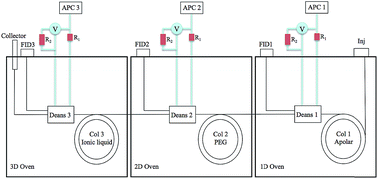
Faraday Discuss., 2019,218, 101-114
https://doi.org/10.1039/C8FD00234G
Structural analysis of heavy oil fractions after hydrodenitrogenation by high-resolution tandem mass spectrometry and ion mobility spectrometry
The purpose of this study was to identify and characterize compounds that are refractory to the hydrodenitrogenation process.

Faraday Discuss., 2019,218, 417-430
https://doi.org/10.1039/C8FD00239H
Characterising polar compounds using supercritical fluid chromatography–nuclear magnetic resonance spectroscopy (SFC–NMR)
In this work, a novel SFC–NMR setup was successfully adapted to separate and characterize polar compounds in complex matrices.
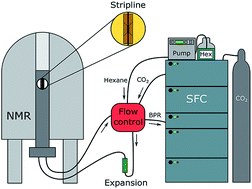
Faraday Discuss., 2019,218, 219-232
https://doi.org/10.1039/C8FD00237A
Polar mixture analysis by NMR under spin diffusion conditions in viscous sucrose solution and agarose gel
A viscous sucrose solution is used for the first time to access individual NMR spectra of mixture components under spin diffusion conditions.
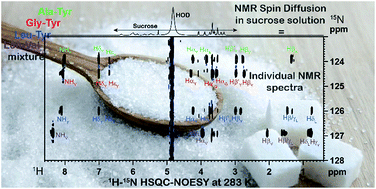
Faraday Discuss., 2019,218, 233-246
https://doi.org/10.1039/C8FD00226F
Focusing on “the important” through targeted NMR experiments: an example of selective 13C–12C bond detection in complex mixtures
Here, a targeted NMR experiment is introduced which selectively detects the formation of 13C–12C bonds in mixtures.
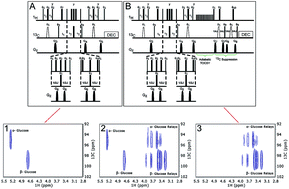
Faraday Discuss., 2019,218, 372-394
https://doi.org/10.1039/C8FD00213D
Dealing with complexity: general discussion
Faraday Discuss., 2019,218, 138-156
https://doi.org/10.1039/C9FD90055A
Future challenges and new approaches: general discussion
Faraday Discuss., 2019,218, 505-523
https://doi.org/10.1039/C9FD90046B
Data mining and visualisation: general discussion
Faraday Discuss., 2019,218, 354-371
https://doi.org/10.1039/C9FD90044F
High resolution techniques: general discussion
Faraday Discuss., 2019,218, 247-267
https://doi.org/10.1039/C9FD90045D
About this collection
We are delighted to share with you a selection of the papers which will be presented at our Faraday Discussion on Challenges in analysis of complex natural mixtures taking place in Edinburgh, UK in May 2019. More information about the event may be found here: http://rsc.li/mixtures-fd2019. Additional articles will be added to the collection as they are published. The final versions of all the articles presented and a record of the live discussions will be published after the event.
Structure determination of molecules contained within unresolved complex mixtures represents an unsolved question that continues to challenge physical and analytical chemistry. Most naturally occurring systems can be characterised as complex mixtures and examples to be discussed at the meeting include:
- environmental matrices such as soil, dissolved organic matter, organic molecules contained in atmospheric aerosol particles, or crude oil,
- biofluids,
- man-made mixtures of small molecules such as food, beverages or plant extracts.
The techniques best positioned to tackle such mixtures experimentally include mass spectrometry, chromatography, NMR spectroscopy, or new alternative techniques, including combinations of the above methods. For the most part, people who work on the analysis of complex mixtures are driving progress in exploiting new methodologies and their creative combinations.
This meeting will discuss a vision for developing this field, bringing together scientists who may not ordinarily meet.